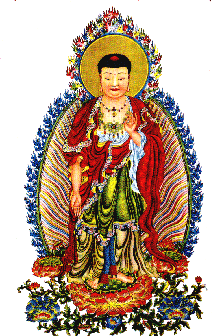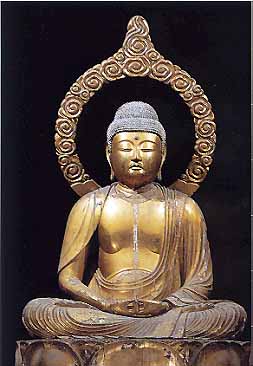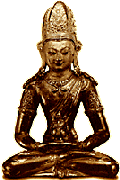|
 The name Amitabha (also Amita) means " Infinite
Light " or "Boundless Light". The name Amitabha (also Amita) means " Infinite
Light " or "Boundless Light".
In Chinese he is called
A-Mi-Tor-For. (Fig 1)
In Japanese he is called Amida Nyorai. (Fig 2)
In Tibetan he is called 'Od-Dpag-Med. (Fig 3)
Amitabha is one of the most important and popular buddhas
of the Mahayana. Although there are six principal purelands (namely east,
west, south, north, up, and down) described in the sutras, Amitabha is at
the center of the worship of the Pure Land school of Chinese and Japanase
Buddhism (Amidism), and this sect has been widespread in Asia.
 This buddha resides in the western direction in the
pureland called Sukhavati (Chinese:Ji-Ler-Shi-Jei, Tibetan: Dewachen).
According to tradition Amitabha was a king who, having come in contact
with the Buddhist teaching, renounced his throne and became a monk with
the name Dharmakara. He took forty-eight vows obliging him to sustain
beings on the path to enlightenment. One of the important vows was to
refuse personal salvation, unless he should gain power to cause any being
that remember his name with faith to him at the time of their death to be
reborn in the pureland immediately after death. Through meditative
practice, Dharmakara fulfilled his vows and eventually became Buddha
Amitabha, ruler of Sukhavati. The being reborn in this land will achieve
enlightenment without future rebirths. This buddha resides in the western direction in the
pureland called Sukhavati (Chinese:Ji-Ler-Shi-Jei, Tibetan: Dewachen).
According to tradition Amitabha was a king who, having come in contact
with the Buddhist teaching, renounced his throne and became a monk with
the name Dharmakara. He took forty-eight vows obliging him to sustain
beings on the path to enlightenment. One of the important vows was to
refuse personal salvation, unless he should gain power to cause any being
that remember his name with faith to him at the time of their death to be
reborn in the pureland immediately after death. Through meditative
practice, Dharmakara fulfilled his vows and eventually became Buddha
Amitabha, ruler of Sukhavati. The being reborn in this land will achieve
enlightenment without future rebirths.
Amitabha's meditative training particularly focuses on
the powers of consciousness that enables ones to transfer their
consciousness into the field of pure perception of Sukhavati at the time
of their death. He is the pure expression of the wisdom of discriminating
awareness, which transmutes the poison of attachment and desire.
Amitabha's Discriminating Wisdom conquers the poison of the passions--all
cravings, covetousness, greed and lust.
 Sometimes Amitabha is depicted with patched saffron
robes of a fully ordained monk, in some mandalas Amitaba is depicted in
union with his wisdom consort Gokarmo, who embodies the pure element of
fire. Most often he is seated in the middle of a lotus blossom, symbol of
spiritual unfoldment, purity, the true nature of beings realized through
enlightenment, and compassion, the purified form of passion. Sometimes Amitabha is depicted with patched saffron
robes of a fully ordained monk, in some mandalas Amitaba is depicted in
union with his wisdom consort Gokarmo, who embodies the pure element of
fire. Most often he is seated in the middle of a lotus blossom, symbol of
spiritual unfoldment, purity, the true nature of beings realized through
enlightenment, and compassion, the purified form of passion.
Although Amitaba is usually depicted as red in color, his
appearance various according to the different practices of tantra in
relation to which he is visualized. This buddha normally sits in the
full-lotus posture with his two hands resting on his lap in the gesture of
meditative equipoise (dhyana mudra) and hold a begging bowl filled with
nectar. He rules over the element of fire and personifies the skandha of
perception.
He is most often depicted flanked by two eminent
bodhisattvas, Avalokitesvara, the Bodhisattva of Compassion and Vajrapani,
the Bodhisattva of Power.
His mantra is Om Amitabha Hrih.
|